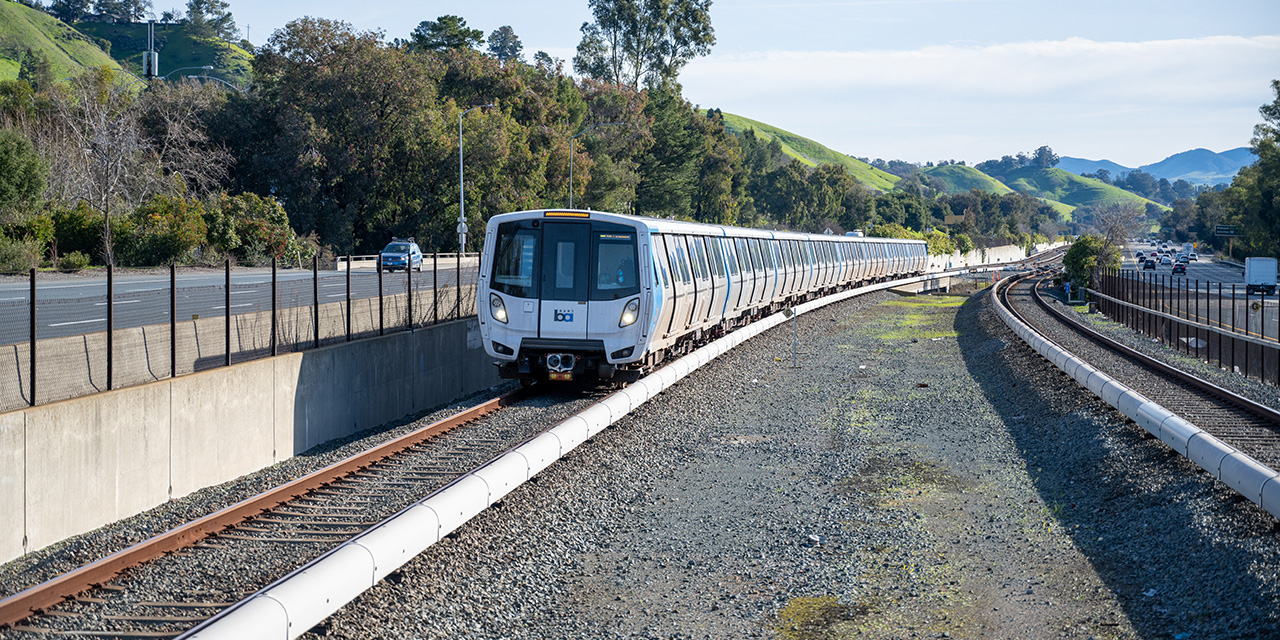
The Bay Area Rapid Transit system was always meant to offer a glimpse of the future. When it debuted in 1972, BART featured sleek, space-age aesthetics and cutting-edge innovations in train control and signaling, running above and below ground through Oakland, San Francisco, and surrounding communities.
Today, BART still previews the future for American cities—but not in the way its designers intended. Soaring costs, driven largely by excessive labor spending, have pushed the system to the brink of bankruptcy. Transit networks in New York, Chicago, Washington, D.C., and elsewhere risk a similar fate if they don’t get their budgets under control.
Finally, a reason to check your email.
Sign up for our free newsletter today.
Beginning next year, BART expects annual deficits of $400 million—nearly a third of its operating budget. Even under optimistic projections, its cash reserves will only cover the shortfall through the end of the decade. With more than $3 billion in outstanding debt and a recent credit rating downgrade, borrowing isn’t a viable option.
Informed observers are now beginning to sound the alarm about an imminent death spiral for a mass transit system that—even after the proliferation of remote work policies—still supports almost 200,000 daily riders in one of the nation’s key economic regions.
To head off this calamity, Sacramento lawmakers are working to pass Senate Bill 63, which would put a sales tax increase on the ballot next November. Shoppers in San Francisco and other Bay Area counties would pay an extra 0.5 percent to 1 percent tax on each transaction. The estimated $550 million raised annually would go not just to BART but also to ten other local transit agencies in financial straits.
Supporters of SB 63 warn that without the bill, BART will face reduced hours, longer wait times, and shuttered lines and stations. They’re both right and wrong.
They’re right that, in the short term, BART needs a major infusion of cash. For years, the system balanced its budget with fare revenue, local sales and property taxes, and state funding. But the pandemic decimated fare revenue, and ridership remains stuck at just 45 percent of pre-pandemic levels. As a stopgap measure, the federal government provided $1.6 billion in aid to BART. That money runs out early next year.
SB 63’s supporters are wrong, however, to think that, absent a new cash source, BART can keep operating simply by cutting back on service hours and train frequency. In fact, BART already undertook such measures in response to the pandemic, yet operating costs continued to rise.
That means two things. First, without new funding, BART confronts a real danger of going bankrupt. Second, even with that funding, if BART doesn’t control its spending, it will face another death spiral in just a few years.
The elephant in the subway is labor costs, which by some estimates claim upward of $830 million from an operating budget of $1.2 billion. The fraud, waste, and abuse rampant among BART’s employees—particularly in devising schemes to inflate overtime wages—is partly to blame. In one recent example, an employee claimed to be working 12-hour shifts for weeks on end, with no days off. Later, it was discovered that he was simply going to the nearest BART station in the morning, clocking in, returning home, then going back to that same station in the evening to clock out.
The more significant driver of costs, however, is BART’s ludicrously generous union contracts. These make employees too easy to hire and next to impossible to fire, while also mandating unsustainable annual wage hikes. Over the past decade, BART ridership has fallen by more than 50 percent, while employee headcount has risen by almost 30 percent and total employee spending has almost doubled.
SB 63 addresses none of BART’s underlying problems. In fact, it makes them worse by funneling what amounts to a slush fund into the system, with minimal oversight.
The bill calls for an oversight committee to conduct a “comprehensive financial efficiency review” of the transit agencies receiving funds. But the review isn’t required before the tax goes into effect, and the legislation sets no firm deadline for its completion. Even if the review is completed, agencies have an open-ended timeline to respond with an implementation plan, and there’s no requirement that they follow through in order to keep receiving funds.
There’s still time for voters to amend the measure to include a serious plan to stabilize BART’s finances. In the long term, they can also elect commissioners to BART’s governing board who aren’t beholden to labor unions or special interests.
The good work done by one commissioner who recently left the board, Debora Allen, shows how bright BART’s future could be. Allen, a former chair of the Contra Costa County GOP with professional experience as a CFO and an accountant, was one of the few non-ideologues to sit on the BART board over the past eight years. While her colleagues were focused on defunding transit police and passing various resolutions in support of “social justice,” Allen was instrumental in the creation of BART’s first independent inspector general’s office and the installation of fare gates that prevent up to $25 million of lost revenue per year and contributed to a 50 percent reduction in crime in the first three months of 2025.
Transit riders in New York, Washington, and other cities should watch closely what unfolds in the Bay Area over the next year. Labor costs consume a large share of operating budgets at agencies like the New York City Transit Authority and the Washington Metro. BART’s ridership recovery may be slower than that of other systems, but its fiscal challenges are far from unique.
Take heed: without a serious course correction, our future could be your future, too.
Photo: Smith Collection/Gado / Contributor / Archive Photos
Source link
















